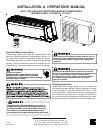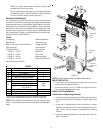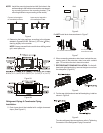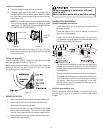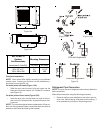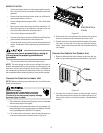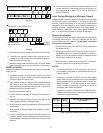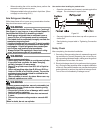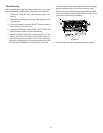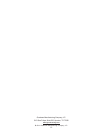
2
CONTENTS
Important Safety Instructions .............................................. 1
Shipping Inspection ............................................................ 1
Codes & Regulations ......................................................... 2
Installation Considerations ................................................. 2
Rooftop Installations ........................................................... 3
Tools .................................................................................. 3
Indoor Unit Installation ........................................................ 3
Outdoor Unit Installation ..................................................... 5
Refrigerant Pipe Connection ............................................... 6
Electrical ............................................................................ 7
Connect the Cable to the Indoor Unit .................................. 8
Connect the Cable to the Outdoor Unit ............................... 8
Leak Testing (Nitrogen or Nitrogen-Traced) ......................... 9
System Evacuation ............................................................ 9
Safe Refrigerant Handling ................................................. 10
Safety Check ................................................................... 10
Test Running ..................................................................... 11
Codes & Regulations
This product is designed and manufactured to comply with
national codes. Installation in accordance with such codes and/
or prevailing local codes/regulations is the responsibility of the
installer. The manufacturer assumes no responsibility for equip-
ment installed in violation of any codes or regulations.
The United States Environmental Protection Agency (EPA)
has issued various regulations regarding the introduc-
tion and disposal of refrigerants. Failure to follow these
regulations may harm the environment and can lead to
the imposition of substantial fines. Should you have any
questions please contact the local office of the EPA.
Installation Considerations
To ensure that the unit operates safely and efficiently, it must
be installed, operated, and maintained according to these
installation and operating instructions and all local codes and
ordinances, or, in their absence, with the latest edition of the
National Electrical Code. The proper installation of this unit is
described in the following sections. Following the steps in the
order presented should ensure proper installation.
2.4m (8 ft.)
MOUNT WITH THE LOWEST MOVING PARTS AT
LEAST ABOVE FLOOR OR GRADE LEVEL.
INDOOR UNIT
To avoid property damage, personal injury or death due to
electrical shock, do not use an extension cord with this unit.
• Do not expose unit to excessive heat.
• Select a location where there are no obstructions in front
or the sides of the unit.
• Be sure that placement of the unit allows adequate con-
densate drainage.
• Do not install near a doorway.
• Ensure that the spaces indicated by the arrows is from
the wall, ceiling or other obstacles (See minimum clear-
ances required in Figure 1.)
• Noise prevention should be considered when installing
the unit.
• Do not place the unit closer than 3 ft. (1m) to a TV or
radio.
• Consideration should be given to the distance from furni-
ture, curtains, or other obstructions that will interfere with
the unit’s airflow.
• Do not exposure the unit direct sunlight. Exposure will
fade the cabinet and affect its appearance. Sunlight
prevention should be considered in placing the unit.
More than 6” (15 cm)
(to the ceiling)
More than
5”
(12cm)
More than 96” (2.4 m)
(to the floor)
More than
5”
(12cm)
Figure 1
OUTDOOR UNIT
When placing the outdoor unit, consider any obstructions that
may constrict the air inlet or outlet. (See Figure 2).
More than
24” (60cm)
More than
12” (30cm)
More than
79” (200cm)
More than
12” (30cm)
Figure 2
• Locate the outdoor unit in a location that will not ob-
struct discharge air from the condenser.
• Do not install outdoor unit in a corrosive environment.
• Keep the clearances from the wall or other obstacles as
indicated by the arrows on Figure 2.
• Do not place animals or plants in the path of the air inlet
or outlet.



